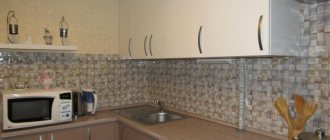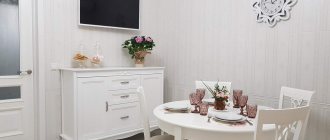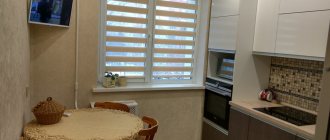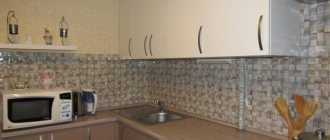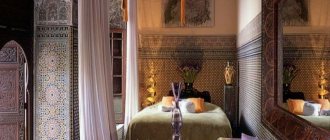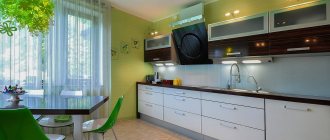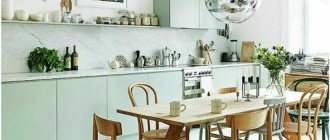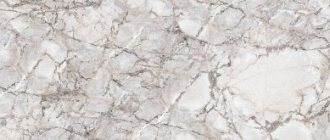Today, dark kitchen floors are an important design trend. This floor can be made from a variety of materials. It looks great both in an antique setting and in modern interiors.
According to design rules, a kitchen should be filled with light and bring joy.
When talking about kitchen design with a dark floor, the following aspects are most often considered:
- material and its texture (imitation wood and stone, ceramic tiles, less often - natural wood and stone);
- zoning of spacious premises: rules and features;
- combination with the overall style of the kitchen interior, color scheme.
There are three main tones - black, brown, gray.
Pros and cons of dark floors in the kitchen
The same properties inherent in dark surfaces can be considered both advantages and disadvantages in different situations.
Black is extravagant, suitable for modern interiors.
Intensely colored or dark floor:
- visually reduces the area of the room,
- combines pieces of furniture, “pulling” them towards the center and adding completeness to the composition.
If you have chosen dark floors for the kitchen, know that they will bring respectability and high cost to the interior.
This property - visually adjusting the size of the room - will be an advantage or disadvantage depending on the area of the kitchen and design tasks. When dividing large rooms into zones - for example, a kitchen combined with a dining room - color helps to highlight the most important “islands”, one or more. Often they even differ in design and style.
A dark floor always looks presentable, no matter where it is laid.
For a designer who decides to offer a black floor in the kitchen, as well as a combination of black and other colors, there are many elegant solutions. You can often find a dark floor in the kitchen, the photo of which shows a light frame with a geometric or floral pattern. This especially applies to private houses or cottages, where they are not constrained by the size of standard apartments, and the kitchen area smoothly transitions into the living room or dining area.
The interior of a kitchen with a dark floor looks fundamental and reliable.
Choosing the main color
Typically, such a kitchen interior is associated with the use of black or different shades of dark wood. But these are not the only options - for a dark, rich interior you can use a number of other shades.
If the entire kitchen is dark (both the furniture, the walls and the floor), this will not be the optimal solution even for a spacious, well-lit room.
Staying in such an environment for a long time can create a depressed mood. Therefore, you should dilute dark shades with light and neutral ones. The optimal ratio depends on the size of the room, its lighting and interior style.
By combining dark and light tones you can zone a room. For example, the set is decorated in brown tones, and the dining area is decorated in beige (or vice versa).
Black kitchen
A black kitchen is one of the most common options for a kitchen in a dark color, well suited for simple interiors with graphic lines. It is used as a dominant feature (black set or wall decoration) in spacious rooms, but in a cramped kitchen it is better to assign black the role of an accent color.
Black contrasts with most shades, so its use requires careful consideration of the color scheme. A black set requires a skillfully selected background; The walls for such furniture are usually made light.
The black floor is characterized by increased soiling - dirt and dust are especially noticeable on it. Those who are thinking about choosing such a covering for the kitchen should take this into account.
It is better to opt for brown or dark gray surfaces: dirt is not so noticeable on them.
Dark wood kitchen
Such dark kitchens will be appropriate both in classic interiors and in some modern styles, for example, loft. The facades are made from solid wood or veneer from species such as bog oak, dark walnut, wenge. They can be smooth or paneled.
Does the color of the floor affect the cleanliness of the kitchen?
The appearance of kitchen floors is often discussed simply from a hygiene perspective. However, maintaining cleanliness using modern products is equally easy regardless of the color of the floor.
Psychologically, a person stands more confidently on a dark floor, because the subconscious associates him with the earth.
Another thing is that small particles of fallen debris can be more noticeable on a light surface, but this is not always the case.
The kitchen, of course, should always be clean, but it is not necessary to achieve sterility, as in the operating room - such a degree of cleanliness is simply not necessary.
On a dark flooring, all the furniture looks advantageous; even simple chairs or an armchair are transformed.
When it comes to cleanliness, what is more important is not the color of the floor, but the ease of cleaning: if the furniture is properly arranged and easy to move, the floor can be any color. It is only important to take care of good quality coating.
During the cooking process, it often happens that some piece flies into a hard-to-reach corner. This means that the furniture should be positioned so that there are as few hard-to-reach corners as possible.
If you have a white set, then a black floor will emphasize the elegance and laconicism of the interior.
All gaps between the working surfaces should be closed, and a “collar” made of heat-resistant material should be provided around the stove. From this point of view, it is very convenient to use cooking surfaces: they and the workspace around them are easier to keep clean.
In such a kitchen there will be no need for additional accents - the dark floor will take on this mission.
What you need to lay floor tiles
Just three things:
- Floor tiles;
- Glue for installation and grout for seams;
- Tool.
And, of course, your desire. But in order to choose the right material, which is not only beautiful to look at, but also most suitable for operating conditions, you should immediately talk about its characteristics.
All tiles differ in size, color and patterns, physical properties and other components that characterize the area of its application.
Elegant kitchens with dark floors: ideas for laconic and stylish kitchen interiors
The most successful design solutions are often based on the contrast of two primary colors, with an additional third. The color of the floor can match one of the colors of the furniture, decor, or be the third color in a two-color furniture set. In this case, dark details would be appropriate - for example, cabinet handles, apron patterns, frames of decorative elements that match in shade.
A dark floor with a matte finish will also help make it easier to maintain.
A kitchen with a black floor looks great if the room is not too small, and the kitchen furniture is dominated by clean, moderately saturated colors.
The main materials used for dark-colored floors in the kitchen are laminate, porcelain stoneware, tiles, and oak parquet.
For a kitchen that is too small, such a solution is psychologically unsuccessful. The shade may not be completely black, but, for example, the color of “bitter chocolate” or violet-gray.
If there is a dark floor in the room, it will always decorate it.
Varieties of dark shades
A floor that is not only black or brown is considered dark. Shades of this type include variations of any colors (green, blue, purple and others). To understand which one to choose, you need to consider the following features:
- black - the interior turns out gloomy, but rich;
- brown is the most common shade;
- gray is a popular color that goes well with different styles;
- dark variations of red, blue and purple are a rare solution.
Marble floor looks noble and expensive
Which kitchen to choose for a dark floor
A furniture set can look good in combination with a dark floor, regardless of whether it is:
- pastel shades,
- bright saturated colors,
- completely or partially repeat the color and dark shade of the floor.
The main thing here is to select the remaining finishing elements so as not to make the room gloomy and gloomy.
The design solution can include any colors, but it is important that they are in harmony. You can follow the rule: do not mix warm and cold shades of the same color, then it is easier to make the room look harmonious.
The classic black and white combination is also suitable for decorating the kitchen.
Important! The color green is especially “insidious” in this regard. It is often used in kitchen design, but the wrong choice of shades of green can be perceived as an unpleasant, aggressive combination of yellow with blue or gray.
Performance characteristics of tiles
The first and most important requirement when choosing floor tiles: they must be floor tiles. This is clearly demonstrated by the foot sign on the tile itself or on the packaging.
Such squares or rectangles have a denser structure, so they can serve faithfully for many years without being subject to wear or abrasion.
In addition, attention should be paid to:
- Wear resistance class. According to GOST, this indicator must be at least 5; according to the international PEI scale, it must be in the range from 3rd to 5th class.
- Resistance to chemical reagents. The best option would be tiles marked A. This option will easily tolerate any household chemicals. The AA marking is even more resistant to aggressive agents; such tiles are most often chosen by housewives who wash the floor every day.
- Slip coefficient. Slippery tiles will always cause injuries. And in the kitchen it is three times more dangerous, because here water often gets on the floor or condensation settles. The best option is a tile with a friction coefficient of at least 0.75. However, you should not choose tiles that are too textured. It will not slip, but difficult-to-remove dirt will accumulate in the depressions.
- Resistant to fading. The sun icon indicates a high level of resistance to ultraviolet radiation. Such tiles will not lose their rich color even in the sunniest kitchen.
Recently, glazed tiles have become very popular. An additional layer of glaze protects the lower layers from all possible troubles.
But when choosing this option, you should buy tiles only from a trusted manufacturer. An incorrectly applied layer of glaze can quickly crack or develop an unsightly patina.
Glossy tiles will make the kitchen cleaner and wider, but the smallest drops of dirt will be clearly visible on it, so such tiles will require much more maintenance. On a matte surface, dirt will not be so noticeable, but it will be much more difficult to wipe off old stains.
The benefits of combining dark flooring with other surfaces and objects
If the floor is dark, then the bright accents of the furniture and decor will appear brighter and richer in color.
When choosing finishing materials you need to be extremely careful.
This may apply, for example, to a specific lighting mode: natural light or one of the lighting options at night.
Dark floor in a light kitchen
This combination is practically a design classic.
Light-colored furniture with a beautiful texture, such as natural wood or marble patterns, is best emphasized with a darker background.
The main thing is not to oversaturate the interior and not make the kitchen irritating.
Attention! It is important that in this situation the kitchen “apron” and other walls are not too bright. Otherwise, psychological discomfort arises.
On the other hand, too many light surfaces nearby look monotonous, so a thoughtful system of decorative elements is necessary.
It is better to choose white cabinets to compensate for the darkness.
An important advantage of the interior according to the scheme “light furniture with light appliances plus a dark floor”: a minimum of decorative elements is enough to transform the room.
If the housewife likes to frequently refresh the interior, then this is easiest to achieve by having a supply of kitchen textiles in different colors. Decorative kits may include:
- curtains, tulle;
- tablecloth and fabric napkins;
- towels,
- cloth potholders,
as well as other items in the selected range.
The chairs and table are matched to the color of the light half of the kitchen, then this will unite the interior into one whole.
With such a set, you can completely transform a room in a short time, and a kitchen with a dark floor will be perceived completely differently.
Advice. Take advantage of this instant transformation if you want to make a pleasant surprise for a loved one.
The most advantageous dark floor sets off one large thing - a kind of design center. Such a center, which in no case should be lost and suffer due to dispersion or lack of attention, could be:
- wall with luxurious photo wallpaper;
- large painting on the wall (still life, collage, original panel);
- two-level or simply a very interesting colored ceiling, including those with curved elements;
- just a non-standard refrigerator: retro-styled, very bright, with intricate painting or other options.
A black floor can be combined with a dark-colored set, while finishing the walls with white is an excellent solution.
Advice. If you want to put a very bright thing in the kitchen - such as a cheerful refrigerator, speckled orange - add support for it: similar lamps or a curtain pattern.
Kitchen with gray floor
What is important here is not the color itself, but the shade. Warm or cold gray, with blue or, conversely, brown nuances, should support the color of the rest of the furniture, and not contradict it or drown out its advantages.
The gray color here will act as a neutralizer, that is, it will balance out the other colors.
If the floor is glossy, it usually looks more respectable than matte.
When selecting materials for finishing a kitchen, you should give preference to the same textures.
If your kitchen has a lot of polished metal and glass surfaces, a mirror effect finish will work well.
Black floors in different kitchen styles
Preferring one style, be it classic or modern, country or high-tech, it is especially important to choose a floor material with the appropriate texture.
If the floor in the kitchen is glossy, then the furniture must be installed with a glossy shine.
Wood, laminate, tile or porcelain stoneware - first of all, the coating must be durable, resistant to various chemical irritants and abrasion. Even after wet cleaning, it is unacceptable for the floor to be slippery.
Acceptable materials in an interior with a dark floor are glass, chrome materials, wood.
The dark color of the floor, matching the shade with the kitchen unit, gives the interior coziness and a feeling of reliability.
A dark-colored floor is always relevant, including in the kitchen.
Porcelain tiles
Black floor color is a special look. This is a kind of charm and chic that not everyone can afford, not because of their financial condition, but because of the framework established in the subconscious regarding the finishing of the floor. Although black porcelain tiles are available in a variety of textures.
You can choose a velvety surface, like fabric, or you can choose a leather-like one. However, such a floor dictates its own conditions for choosing a headset. As a rule, such finishing goes in modern interior directions. Therefore, antique white furniture with bent legs will be completely inappropriate. But acrylic in this case is ideal. Moreover, acrylic with elements of the same black color. Or, if you want a perfect radical contrast, you can install snow-white acrylic furniture with internal handles on a black, plain floor. This is an unusual solution, but such a kitchen will look very impressive.
So, to summarize, the main thing must be said. Black or dark, brown floor is an indicator that influences the choice of finishes and furniture. In order for everything to look pleasant, “melodic” with each other, it is necessary to use the rules of contrast, trying to minimally furnish the room with various interior additions.
Grouting tile joints
With the help of grouting compounds, the laid tiles acquire a finished look. With their help you can create an excellent contrast to the tiled surface.
It should be noted that in addition to the decorative function, the grout also has a very practical purpose - it protects concrete screeds or wooden floors under the tiles from moisture from the environment.
Today, the two most common types of such fillers are:
- Cement based;
- Based on resins (mainly epoxy).
- The first, in addition to cement, contain additives that increase ductility and water resistance. May contain coloring pigments. Designed for filling joints indoors. They are relatively inexpensive.
- The latter are usually two-component. They consist of resin and hardener itself, which, when hardened, form a very durable moisture-proof surface. They are used for grouting joints in all types of premises and even swimming pools.
It is also important that they resist temperature changes very well. Do not react to chemically active substances.
The only downside is the difficulty of working with them due to their viscosity and the difficulty of cleaning the tiles if they are applied incorrectly.
Laying floor tiles is a long and labor-intensive process. It has its own laws, specifics and rules. But if they are followed correctly and completely, the expected end result will certainly be achieved.
Porcelain tiles for the kitchen
In addition, there is such a type of floor tile as porcelain stoneware. In its mechanical properties and appearance, it is very similar to natural granite.
In terms of wear resistance it has V, the highest class. With its help, both indoor floors can be perfectly decorated, tiles can be laid on steps outside the house, and the surfaces of open balconies and terraces can be tiled.
Tile composition
If you plan to decorate a large room, you can create geometric shapes using different shades of tiles. Existing “borders” for tiles will help add contrast to monochromatic coverings or create zoning of an area.
There are even entire floor panels consisting of 4, 8, 9, 16 or more tiles with printed images.
In general, there are many decor options. It all depends on the availability of a good hardware store nearby, your own imagination and financial capabilities.
